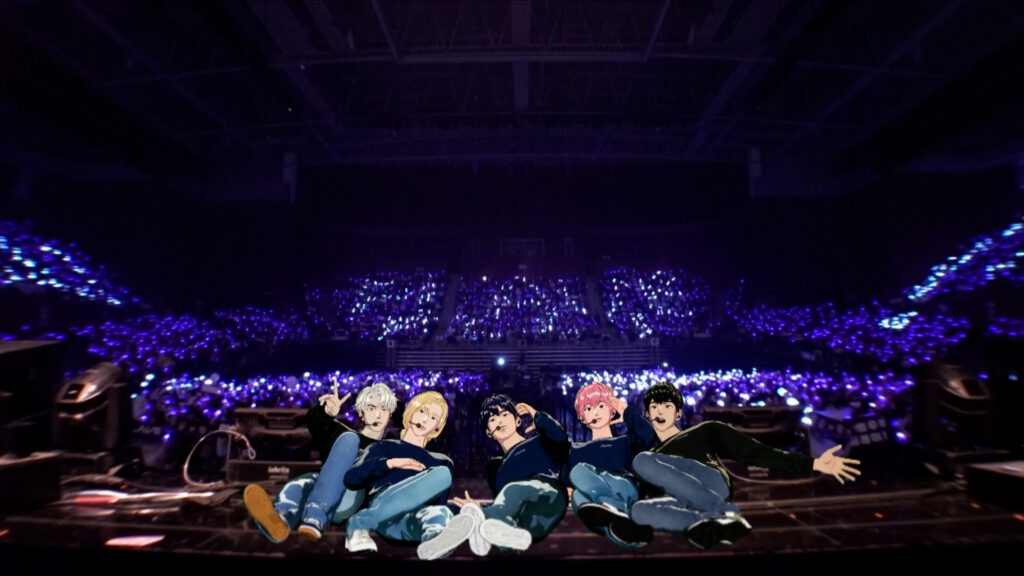It was a warm day in September 2023. Sipping coffee at my office desk, I was scrolling through the recommended videos on YouTube to find a video I could watch during my short break. That’s when I found PLAVE performing on the stage in a TV music program like any other real-world human artist.
PLAVE is a virtual idol band comprised of five members: Nam Ye-jun, Han Noah, Chae Bamby, Do Eun-ho, and Yu Ha-min. The group’s characters – who would rather have more webtoon-ish appearances than other virtual idols with hyper-realistic looks – are built with Unreal Engine, produced by Korean visual tech start-up VLAST.
Real humans, not artificial intelligence, perform the roles. Each has a dedicated performer who sings and dances while wearing their virtual suits and keeping their real-world identities masked. Members say that they all have a career background in the music industry, as either idol trainees or members of idol groups that did not see much success.
The stage performance I watched was their first-ever appearance on a national TV music program. It was the first for a virtual group to be featured in any TV music programs on record. While wondering what technologies assist their operations, little did I know that people around me would soon become big fans of this group back then.
Breathing Life into Virtual Pinocchios
One of the tools used to power PLAVE is motion capture. Capturing motions is not new in video production; placing sensors over an actor’s body and tracking their movements to move a virtual skeleton in computer screens in real-time.
The technology has been deployed in filmmaking for decades, for example, in the creation of Gollum in the Lord of the Rings trilogy. What makes VLAST’s technology different from the old motion capture technology is how they strung their virtual Pinocchios with retargeting solutions powered by Unreal Engine.
When syncing digital skeletons with actors, technicians look for ways to narrow the gap in physical looks between them, like height or body ratio. Motion capture experts can help animators adjust such differences and make digital characters move as close to actors as possible if it is for pre-recorded clips like music videos or movies. For real time actions, there is no space for animators re-adjust.

Music band PLAVE
VLAST solved this pain point through Unreal Engine. The developers livestream the raw data of their human performers into the graphic program and retarget body ratio or other physical positions through it. To avoid awkward collisions or compilations of body parts, like arms going through their stomach due to physical differences, VLAST applied a solution where they traced characters’ lines in each frame to estimate the distance between body parts and applied calculated vectors.
Some other solutions of VLAST to make PLAVE members seem more natural include the auto-scaling feature that preserves characters’ sizes, the reference-pose calibration technology that detects positions of marker dots on actors, and a feature that keeps digital characters’ feet attached to the ground.
Through such automated technical solutions, PLAVE has been broadcasting live or performing without much involvement from developers or animators in real-time. This allowed VLAST—a tech company, not an entertainment agency—to work on cinematic projects on the side while running projects related to their virtual idol band.
Virtual, but Happening in the Real World
Although they exist in the virtual world, PLAVE has shown that they are capable of doing anything that any other K-pop group would do. They livestream twice a week on YouTube, release new songs and choreographies, perform on TV music program stages, and even do fan meet-and-greets through video calls.

Idol band South Korea
PLAVE is reaching a new career high with their latest album, “ASTERUM: 134-1,” which was released in February. The band sold over 560,000 copies of the album during its first week of release, the 17th-highest record among all K-pop boy group releases. PLAVE even topped the weekly chart of Music Core in the same month, one of Korea’s three biggest TV music programs, which was the first for a virtual group.
Most recently, the group was in the media spotlight for hosting big offline events. One was PLAVE’s pop-up store – a shop temporarily open to promote brands’ products or services–to celebrate their debut’s first anniversary. The store was open at The Hyundai Seoul from 15 February to 17 March, along with pop-ups of two other virtual bands, Isegye Idol and StelLive. Reports say that the total sales of these virtual bands’ stores recorded over 7 billion won (US$ 5 million), about seven times bigger than the monthly sales volume of any fashion-themed pop-up stores in the shopping mall.

Another major event was the group’s fan concert that happened at Olympic Hall, Seoul, on 13 and 14 April. The venue can accommodate up to 3,000 people, but more than 70,000 users visited the ticket seller’s website during pre-sales, and the tickets were sold out within 10 minutes, according to reports. The second day of the concert was livestreamed via the K-pop artist platform Weverse for those who could not buy tickets to the offline event.
Human Qualities that Overcome Dimensional Borders
When PLAVE started to rise to the mainstream, several reports suggested that the group must be gaining popularity because the performers’ real identities were hidden, meaning that they would have less risk of having scandals or being involved in troubles that would force them to quit the band.

Virtual idol
However, PLAVE fans say that the human aspect has attracted thousands of people. Shin Yu-jin, a PLAVE fan based in Gumi, Gyeongsang Province, says that she was initially drawn to the band because of fun interactions among the members. “What made me intrigued was their live broadcasts on YouTube, where the chemistry of their personalities shine through,” Shin told 4i Magazine. “This is because the members have known each other even before the debut,” she adds.
The back story of the members before the debut was the next thing that immersed Shin more in the band’s world. “All members experienced frustration in their previous musical career, retiring without much success. Being part of a virtual band is like a second chance for them to pursue their forgotten dreams again. Such a story makes fans hope for their success,” Shin explains.

As they are a K-pop band after all, part of PLAVE’s popularity can be explained by how good their music is. In an interview, Lee Sun,g-gu, VLAST’s CEO, said that the band produces songs and choreographies by itself and could not receive any good works from well-known songwriters or dancers due to being a virtual band. Thanks to this, their taste in music is distinguished from that of many other bands. Since their debut album, PLAVE has been making songs that are easy to listen to and sing along. “We made the songs to sound easy-to-listen,” the band’s leader, Ye-jun, said in a live broadcast.
“We want to develop our virtual diol group as an IP that can grow through communication between fans and artists, rather than just emphasising technological skills,” Lee was quoted as saying. “In creating virtual idols, technology is important, but we do not forget that good music and content are the key factors to gaining love from fans.”



